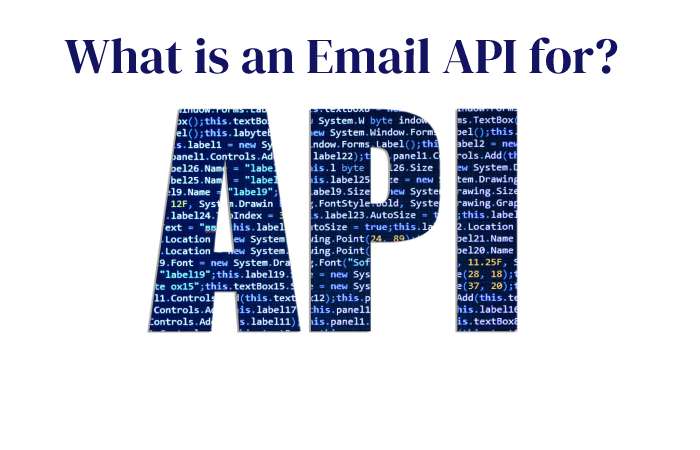What is an Email Marketing API, and What is its Function? – Email marketing is a practically essential ingredient of digital marketing. In addition to having an unbeatable ROI, it is a super versatile tool capable of adapting to all types of brands and campaigns. This article will discuss a resource that makes it even more helpful: email APIs.
Using APIs in your email marketing allows you to integrate email into other applications and manage your campaigns more efficiently. We tell you what email APIs are, what they are for and examples.
Also Read: Texas Tech Basketball
Table of Contents
What is an Email API?
An API Application Programming Interface is a usual of definitions and protocols used to integrate application software that allows two applications to communicate with each other to accomplish different functions.
Thanks to APIs, developers can access the different functions of a software application using code instead of logging into the application. The developer submits a request using an API key unique to their account. Once your request is acknowledged, you will be able to access various application features as specified in the API documentation.
Specifically, the email APIs allow other applications to access the features available in an email platform. Such as generating and sending transactional emails. Manipulating templates and accessing email metrics. Such as the number of emails sent, emails rejected by the email provider, opens, or clicks.
Also Read: National Fitness Center
What is an Email API for?
APIs have many uses in email marketing and digital marketing in general. These are some of the most used.

Send Automatic Messages
By using an email marketing API, we can send different types of scheduled messages from a website or an application:
Email notifications use to notify the user of something important related to their account; for example, their subscription to a particular service will expire. Being able to send these types of messages automatically is essential to scale the customer base.
Transactional messages are triggered by a user action, for example, a purchase on an ecommerce site. With an email API, you can send transactional emails with the design you prefer and with all the information you consider essential.
Reminder emails can encourage customers who have recently purchased from you to leave a review, boost abandoned cart recovery, and much more.
Email marketing APIs allow you to manage marketing automation in a very fluid and complete way, guaranteeing that the information reaches users at the most appropriate time.
Connect other Software Tools
One of the critical use cases of APIs is to connect some applications with others and take advantage of their functionalities together. That is, you can not only secure the email API with your website but also with other third-party tools that you use regularly.
The tools most frequently used with email APIs are:
CRM – Using an email API, you can automatically sync your email contacts with your CRM tool or set up emails automatically when a connection meets specific requirements.
CMS: connecting an email API to your content manager allows you to send automatic emails when you make updates to the site, such as informing your followers every time you publish new content.
Improve Email Marketing ANALYTICS
As we have mentioned before, email APIs allow access to functionalities and statistics on the performance of emails. Therefore, you can use them to create custom dashboards and reports and control precisely the information you need at any given time.
Also Read: Texas Tech Basketball
Five Examples of Email Marketing APIs
SendGrid.
This email marketing API is best known and used by large companies like Uber, Spotify, and eBay. Its biggest advantages are the high delivery rate and the analytics panels. The free plan includes 100 emails per day. Paid plans are $14.95 per month for 30,000 emails and $199.95 per month for 300,000 emails.

Postmark.
The Postmark Email API only supports transactional emails, not marketing emails. It offers excellent delivery speed since its goal is to send all emails in less than 10 seconds. It also has complete documentation and is very transparent with its statistics. The biggest drawback is that the free plan is limited (it only offers 100 emails per month). The paid plan costs $35 per month for 30,000 emails and $200 per month for 300,000.
Send In Blue.
This solution focuses on providing a complete and cost-effective service. It includes SMS messages and other marketing tools, such as chatbots. Its strong points are a high delivery rate, good documentation and ease of use. The free plan includes 300 emails per day; the paid ones cost $25 per month for 30,000 emails and $173 for 300.00.
Spark Post.
This email API stands out on the technical side: it claims to have the best delivery rate in the industry and an uptime of 99.99%. In addition, it includes real-time metrics and performance alerts. The experience for the developer is also excellent since it has many libraries and complete documentation. The trial plan consists of 500 emails per month, and the paid ones cost $20 for 30,000 emails and $205 for 300,000.
Amazon SES.
Amazon’s solution is incredibly competitively priced and fast and reliable, but features are limited, and documentation is more complex than other options. Amazon EC2 users can send up to 62,000 emails monthly for free or 300,000 for $23.8. Standard paid plans are $3 per month for 30,000 emails or $23.8 for 300,000.
Power App notifications and transactional messages
The most common reason companies are likely to use an email marketing API is to programmatically add email notifications and transactional messages to their website or software tool.
Notifications
Many software tools and websites use notifications to notify users when something happens to their account on the platform. In social media tools like Facebook or Instagram, this can be a new comment or a like on a user’s post.
It doesn’t always make sense to send an email for every action that takes place in an app. However, if it is a more important or urgent action that requires the user’s attention, sending an email can be a great mechanism to ensure that the user sees the information on time.
For a great example of how email notifications are integrate into an app, see the Airbnb email below:
This email is sent automatically from the Airbnb website using an email marketing API to remind users of an upcoming booking they made on the platform.
Of course, if you only have one or two clients, it would be possible to send that email manually by signing up with an email marketing platform. But to achieve any scale, they require integration via a messaging API.
Also Read: Today Redeem Code Ff
Transactional Messages

You’re probably familiar with transactional emails if you’ve shopped online or made in-app purchases. These messages convey up-to-date information, usually related to a specific transaction the user is making on a website or application. The most common sample would be an order confirmation.
Email marketing API allow you to design beautiful transactional emails and integrate them directly into your website’s functionality. Allowing you to use the full potential of a well-crafted email instead of just inserting the important material for customers.
LimeBike uses an email marketing API to send transactional email revenues when money is added, including the customer’s referral code and a beautiful HTML design.
Sometimes email marketing platforms offer plugins for the most popular e-commerce CMS systems. Making it easier to customize transactional messages without requiring the API. For example, Sendinblue has powerful additions with WooCommerce, Shopify, and WordPress. However, if you’re using a less common e-commerce system or building a software tool from scratch. Your transactional messages can still be customized via an email marketing API.
Also Read: Around the Clock Fitness
Customize Your Activation And Growth Hacking Workflows
Email can also be useful for increasing engagement with your growth equitation or product engagement systems. For sample, you might want to send an email prompting users to leave a review about a specific product they’ve procured. It can be done using an email marketing API to send the message at the most opportune moment so you can generate more appointment and provide useful product information to other customers.
Connect Other Software Tools To Your Email Marketing
APIs be so developers can connect the functionality of one tool to another. So, in calculation to connecting your email marketing tool to software or websites you create. You can also use an email marketing API to connect it to other tools you use.
Two of the most mutual types of tools you might connect our CMS and CRM systems:
- CMS: If you use a CMS to put out content on your website, you can use an email marketing API to automatically email your email contacts when you post a new post published to your website.
- CRM: You can practice an email marketing API to robotically synchronize your email contacts with your CRM tool or set up triggers when contacts meet certain criteria in your CRM to robotically email them to send that you designed in your email marketing platform.
These are just two instances, but if you’re using a tool with an API, And can see how email fits in with it. You can easily connect it to your email marketing programmatically via the API.
Conclusion
There are many different reasons why someone must use an email marketing API. Which is why it’s important to understand what features exist for using an API. However, scalability is one thing to remember when choosing between different email marketing API providers. You never want to be let down when your business growing rapidly, and the email API. Solution you’ve been using to integrate with your business can’t keep up (or worse, the pricing scales are beyond what you’re hoping for can afford).
If you’re a website owner or developer look for an email marketing API that scales effectively to any volume. While maintaining a reasonable price, check out Sendinblue. Our pricing is based solely on the volume of emails you send from the platform (rather than the number of contacts). So you can quickly scale your business without worrying about price jumps.

